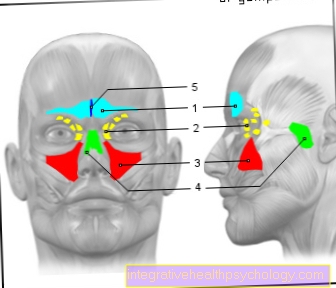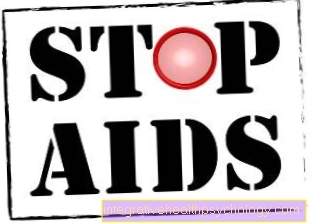Urinary tract infection in children - how dangerous is it?
definition
A urinary tract infection is an infection of the urinary tract, which is usually caused by bacteria and only very rarely by viruses.
In most cases, the urethra, the connection between the bladder and the outlet, becomes inflamed.
In more rare cases, the urinary bladder itself or the ureter, which carries urine from the kidney to the bladder, can also be inflamed.
Typically, girls are significantly more likely to suffer from urinary tract infections than boys.

causes
Various causes can be considered for the development of a urinary tract infection. Most commonly, the urinary tract infection is caused by bacteria from the intestines.
In children in particular, the urethral exit in the diaper also comes into contact with the stool. Bacteria excreted from the intestine can enter the urethra and cause a urinary tract infection there.
Therefore, the most common pathogens causing urinary tract infections are enterobacteria from the intestine. These include bacterial species such as E. coli, Proteus mirabilis and Klebsiella. Enterococci and staphylococci can also cause urinary tract infections.
Viruses can also be responsible for urinary tract infections, especially in children; in most cases, an infection with adenoviruses is the basis for the viral urinary tract infection.
- For more information about the causes of urinary tract infections, please also read: Cystitis from cold / cold feet
Less common causes of urinary tract infection in children are abnormalities in the anatomy of the urinary tract. Boys sometimes have to deal with a narrowing of the foreskin (so-called phimosis). This can make hygiene in the genital area difficult. Bacteria can quickly accumulate under the foreskin - i.e. directly at the entrance to the urethra - which can then trigger a urinary tract infection.
Some children are also particularly susceptible to more complicated urinary tract infections. The bacteria rise through the urethra into the bladder and from there up into the ureter. This occurs especially when reflux occurs (backflow of urine from the bladder up into the ureter). Usually this is also the result of a small misalignment of the ureter structure.
- For more detailed information on the causes of a urinary tract infection, read our article: What are the typical causes of a urinary tract infection?
diagnosis
The diagnosis of urinary tract infection is carried out in a urine sample. It is important to take the urine sample cleanly so that it is not contaminated by normal (naturally occurring) skin germs which are then mistakenly mistaken for pathogens.
Various substances such as bacteria, blood cells, inflammatory cells and degradation products of the bacteria can be detected in the urine sample using a urine stix (a small test strip).
You can also look at the urine under a microscope and find bacteria there.
A so-called urine culture should be created in order to prove the triggering germ. A few drops of urine are placed on a nutrient medium and then observed whether bacteria grow there and if so, which ones.
- For more detailed information, read our article Urinalysis.
Concomitant symptoms
A urinary tract infection in children is typically associated with what is known as dysuria. This leads to a burning sensation and pain when urinating.
In addition, the urine stream can be altered by the urinary tract infection. The urine stream may increase or decrease when urinating.
A change in the color of the urine can also indicate a urinary tract infection in the child. In addition, the urine in the toilet can foam unusually.
In children who can already control their bladder emptying, urinary retention can also occur. Because of the pain when urinating, the children refuse to go to the toilet, causing the urine to build up in the bladder. This can lead to uncontrolled and unwanted loss of urine.
Children who are not yet able to express themselves clearly (with words) are often particularly tearful and weak when they have a urinary tract infection. In children, a urinary tract infection can also be accompanied by a fever. If there is also a bladder infection, pain in the lower abdomen (in the area of the bladder) also occurs.
In more severe cases, the infection can also migrate from the bladder to the kidneys. This manifests itself in flank pain (on the side of the back), which can occur on one or both sides.
The children are often very weak and tearful, they have no appetite and drink little despite their fever.
fever
Fever is a very unspecific symptom, especially in children. A fever can occur with every infection, as the increased temperature is a very good measure for the body to fight pathogens. In the case of urinary tract infections, too, the main purpose of the fever is to weaken the triggering bacteria.
If the children have a fever, they are also very tired, limp and cry a lot, they have little appetite and do not drink much.
Often they don't feel like playing and would rather lie down and sleep.
Do you suspect a urinary tract infection in your child?
- You may also be interested in the following article: How contagious is a urinary tract infection?
Pain
Pain can occur in different places depending on the severity of the urinary tract infection.
At the beginning, the pain manifests itself mainly when urinating.
If the urinary tract infection moves up to the bladder, the pain can also appear in the lower abdomen (where the bladder is).
In the case of a complicated urinary tract infection that also affects the kidneys, flank pain can also occur. These are located at the lower end of the costal arch, on the side of the back.
- This article might also interest you: Kidney pain after a bladder infection
How contagious is a urinary tract infection in a child?
Urinary tract infections in children are usually not contagious.
For infection to occur, the bacteria would have to reach other people from the child's urinary tract and the person concerned would in turn have to ingest the bacteria through their mouth, for example.
Since most of the pathogens causing urinary tract infections are normal intestinal germs, many people cannot be infected with these pathogens separately - they already have the bacteria in their own intestinal tract.
- Read more about contagion in our detailed article: How contagious is a urinary tract infection?
General treatment
The therapy of an uncomplicated urinary tract infection consists primarily of symptomatic treatment. Treatment with an antibiotic is not always absolutely necessary. There are a variety of other treatment options available today.
Above all, it is important to drink enough (increased) amounts of water to flush the bacteria out of the urinary tract. Increased drinking “flushes” the urinary tract, including the kidneys and bladder, and is therefore an effective method of fighting the infection.
For the treatment of urinary tract infections, urinary teas or urinary acidifying substances can also be used, as the bacteria cannot multiply in every pH value. Drinking Vitamic C effervescent tablets can help.
According to some studies, concentrated cranberry juice can also fight the infection. The extracts of the cranberry juice are supposed to prevent the most common cause of bladder infections - E.coli - from attaching to the wall of the urinary bladder.
- You may also be interested in this article: Home remedies for cystitis
If you know the reason for a fever in children, treatment of the elevated temperature is not necessarily necessary, as the fever is also useful for combating the infection.
However, if the temperatures are very high (over 38.5-39 ° C) or the children suffer from their weakness (with possibly loss of appetite, headaches and no desire to drink), therapy with antipyretic drugs (paracetamol, ibuprofen) can be useful.
These drugs also have an anti-inflammatory and pain-relieving effect and can not only relieve the symptoms, but also fight the infection directly.
Frequently, urinary tract infections in children should also be treated with prescription antibiotics. Please consult your family doctor to clarify whether treatment with antibiotics is advisable.
Antibiotics such as amoxicillin, gentamycin and ceftriaxone are used here. Which antibiotic is chosen usually also depends on which causative bacterium grows in the urine culture. The antibiotic therapy can be adapted to this.
In the case of urinary tract infections that also affect the bladder and kidneys, stronger drugs tend to be used than in the case of uncomplicated urinary tract infections that only affect the urethra.
- For more information on therapy, read our detailed article: Cystitis therapy
Which home remedies can help?
Home remedies can mainly help relieve symptoms of urinary tract infections.
There are many home remedies that can make the children drink more.
While children should normally be offered water and unsweetened tea to drink, fruit juices can also be used in the event of a fever or urinary tract infection. Ideally, you mix a fruit juice with the same amount of water (sparkling or still, depending on the child's preference).
Due to the sweetness in the drink, the children usually drink more than usual.
The diet can also be adjusted a little so that the children take in plenty of fluids. Soups are particularly suitable for fever and urinary tract infections to optimize the fluid balance.
Other home remedies can be used specifically against the fever:
So calf compresses or a cold washcloth on the forehead can relieve the temperature a little.
- Find out more about this at: Home remedies for a fever
If the child complains of abdominal pain due to the urinary bladder inflammation, a hot water bottle is also an option.
You should make the hot water bottle half full, then squeeze out the remaining air and only then screw it off. This prevents the hot water bottle from bursting if the pressure is too high.
- Find out more about this at: Home Remedies For Abdominal Pain - Which Are The Best?
If the children are particularly broken and grouchy, it often helps to hold them in your arm or lap and calm them down with a story or song.
Even your favorite cuddly toy can work wonders for sick children.
Would you like to read more about the possible home remedies for cystitis?
- Find out more in our detailed article on the subject: Home remedies for cystitis
When does my child need an antibiotic?
In the case of a urinary tract infection in children, antibiotic therapy should be used in most cases.
The exception are urinary tract infections that are triggered by viruses, since antibiotics are not effective here.
Basically, the following rule applies to urinary tract infections:
Infections without symptoms do not have to be treated with antibiotics!
So if there is an incidental finding that the children have bacteria in their urine, it is not yet a cause for concern.
Especially in children who still wear diapers, intestinal bacteria in the urethra area are perfectly normal.
Antibiotic therapy only makes sense when symptoms such as fatigue, painful urination and fever are added. Please contact your pediatrician for this.
Can this harm my child?
An uncomplicated urinary tract infection that occurs once does not cause any harm to children.
Only when complications arise can this become a problem.
For example, the infection can spread throughout the body and lead to inflammation of the kidneys. It is therefore particularly important to treat cystitis properly if symptoms occur and to consult a doctor.
Antibiotic therapy is also not always cheap for children, as it can mess up the intestinal bacteria.
However, in the case of a urinary tract infection, antibiotic therapy is useful in order to avoid complications.
If urinary tract infections occur repeatedly or if these are not adequately treated, the urinary tract can be damaged.
Are you worried about the undesirable effects antibiotics could have on your child?
- Read our article on the topic: Side effects of antibiotics
Which antibiotics are used?
Various antibiotics are used to treat urinary tract infections in children.
Amoxicillin, gentamycin and ceftriaxone are most commonly used.
Depending on which pathogen is found in the urine culture, other antibiotics can also be selected.
These include tobramycin, ceftriaxone and amoxicillin in combination with clavulanic acid.
For children over 12 years of age, a one-time antibiotic can be used, which is purchased in the pharmacy as granules and drunk at home with some water. The active ingredient in this preparation is fosfomycin. It is usually used in women - consult your pediatrician about whether it is possible to use it in your child.
Homeopathy for a urinary tract infection
Urinary tract infections in children can be treated with homeopathic remedies in addition to antibiotic therapy.
Apis is the method of choice for sharp pain.
Cantharis can also be taken for painful urination.
If a cold occurs in addition to the urinary tract infection, Dulcamara can be a sensible alternative.
Other homeopathic remedies for urinary tract infections are, for example, Sarsaparilla, Pulsatilla and Nux vomica.
- For more information, check out our in-depth article on: Homeopathy for cystitis and pelvic inflammation
Which complications can arise from a urinary tract infection?
The complications that arise in a child with a urinary tract infection mainly occur when the pathogens spread further in the body.
Urinary bladder inflammation is a frequent occurrence, which occurs much more frequently in girls than in boys due to the significantly shorter urethra.
If the bacteria can rise from the bladder through the ureter to the kidneys, a condition known as pyelonephritis (inflammation of the kidney pelvis) can develop. Renal pelvic inflammation can also be treated well with antibiotics; if this does not succeed, however, it can lead to a generalized infection in the body up to life-threatening blood poisoning.
A single urinary tract infection is usually not a cause for concern.
However, if urinary tract infections occur more frequently, especially in combination with inflammation of the renal pelvis, permanent kidney damage with functional impairments can occur.
In the case of recurring urinary tract infections, it is also important to clarify the cause.
Are you unsure about the cause of your child's urinary tract infection?
- Find out more in our article: What are the typical causes of a urinary tract infection?
In children, inflammation of the testicles can also occur as part of a urinary tract infection.
Duration
The duration of the urinary tract infection is usually around a week.
The symptoms can regress completely within this time with antibiotic therapy and possibly fever reducers.
If there are additional infections of the urinary bladder or the kidneys, the duration of the urinary tract infection in the child can be significantly longer.
Recommendations from the editorial team
- Urethral pain - that's behind it
- Cystitis - this is the therapy
- Home remedies for cystitis
- Bacteria in the urine - is that bad?
- Everything about pelvic inflammation

























-de-quervain.jpg)



